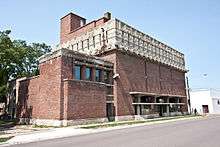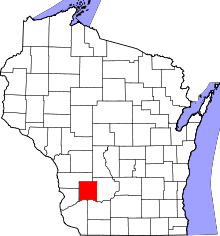Richland Center, Wisconsin
| Richland Center, Wisconsin | |
|---|---|
| City | |
|
Richland Center's historic downtown, viewed from Court and Main Street. | |
 Location of Richland Center, Wisconsin | |
| Coordinates: 43°20′16″N 90°23′5″W / 43.33778°N 90.38472°WCoordinates: 43°20′16″N 90°23′5″W / 43.33778°N 90.38472°W | |
| Country | United States |
| State | Wisconsin |
| County | Richland |
| Area[1] | |
| • Total | 4.36 sq mi (11.29 km2) |
| • Land | 4.28 sq mi (11.09 km2) |
| • Water | 0.08 sq mi (0.21 km2) |
| Elevation[2] | 728 ft (222 m) |
| Population (2010)[3] | |
| • Total | 5,184 |
| • Estimate (2012[4]) | 5,116 |
| • Density | 1,211.2/sq mi (467.6/km2) |
| Time zone | Central (CST) (UTC-6) |
| • Summer (DST) | CDT (UTC-5) |
| Area code(s) | 608 |
| FIPS code | 55-67625[5] |
| GNIS feature ID | 1578616[2] |
| Website |
ci |
Richland Center is a city in Richland County, Wisconsin, United States, which also serves as the county seat. The population was 5,184 at the 2010 census.
History
Richland Center was founded in 1851 by Ira Sherwin Hazeltine, a native of Andover, Vermont. Hazeltine was drawn to the site because of its abundant water power, fertile prairies, and its proximity to the geographical center of Richland County. Haseltine offered to donate land to the county if Richland Center was voted the county seat.[6] In 1852 the Wisconsin Legislature formally declared Richland Center as the seat of justice for Richland County.[7] The present Richland County courthouse was built at Richland Center in 1889.
In 1876, a narrow gauge railroad branch connected Richland Center with the Chicago, Milwaukee & St. Paul Railroad at Lone Rock, Wisconsin, providing an outlet for the town's commerce. The line was originally constructed with maple rails, but it was rebuilt as a standard gauge iron railway in 1880.[8] On October 8, 1882, the town's railway depot was destroyed when an early morning fire ignited two kegs of gunpowder stored inside, causing an explosion that tore the roof from the building and scorched several nearby rail cars.[9] Another passenger depot, built in 1909, still stands today, serving as a visitor center for the community.[10]
Richland Center became an important location for the women's suffrage movement in Wisconsin after Laura Briggs James, Julia Bowen, and other residents founded the Richland Center Woman's Club in early 1882. The club quickly became the largest suffrage group in the state and was influential in organizing the movement throughout Wisconsin.[11] Susan B. Anthony visited Richland Center in 1886. Later, Laura James' daughter Ada James became influential in the movement, helping to found the Political Equality League in 1909 and advocating for women's rights, pacifism, birth control, and prohibition.[12]
Frank Lloyd Wright was born at Richland Center in 1867. The A. D. German Warehouse, completed in 1921, is the only building designed by Wright in the city and is an early example of his Mayan Revival style.

The origin of GTE can be traced to the Richland Center Telephone Company. In 1918, three Wisconsin public utility accountants (Sigurd L. Odegard, John A. Pratt, and John F. O'Connell) purchased the Richland Center Telephone Company for $33,500. At that time, the modest company served only 1,466 telephones in southern Wisconsin. But in 1920, the three accountants formed the Commonwealth Telephone Company and engaged in an aggressive acquisition program, which dramatically expanded its services to more than 500,000 telephones in 25 states. Following bankruptcy during the Great Depression, the company reorganized into the General Telephone Corporation and continued to expand. After merging with Sylvania Electric Products in 1959, it once again changed its name, this time to General Telephone & Electronics Corporation (GT&E, later GTE). By 1969, GTE provided service to 10 million telephones across the nation, making it the largest independent telephone company in the United States.
Geography
Richland Center is located at 43°20′16″N 90°23′5″W / 43.33778°N 90.38472°W (43.337836, -90.384605).[13]
According to the United States Census Bureau, the city has a total area of 4.36 square miles (11.29 km2), of which, 4.28 square miles (11.09 km2) is land and 0.08 square miles (0.21 km2) is water.[1]
The Pine River runs along the western edge of the town.
Demographics
| Historical population | |||
|---|---|---|---|
| Census | Pop. | %± | |
| 1880 | 1,227 | — | |
| 1890 | 1,819 | 48.2% | |
| 1900 | 2,321 | 27.6% | |
| 1910 | 2,652 | 14.3% | |
| 1920 | 3,409 | 28.5% | |
| 1930 | 3,632 | 6.5% | |
| 1940 | 4,364 | 20.2% | |
| 1950 | 4,608 | 5.6% | |
| 1960 | 4,746 | 3.0% | |
| 1970 | 5,086 | 7.2% | |
| 1980 | 4,997 | −1.7% | |
| 1990 | 5,018 | 0.4% | |
| 2000 | 5,114 | 1.9% | |
| 2010 | 5,184 | 1.4% | |
| Est. 2015 | 5,013 | [14] | −3.3% |
2010 census
As of the census[3] of 2010, there were 5,184 people, 2,361 households, and 1,235 families residing in the city. The population density was 1,211.2 inhabitants per square mile (467.6/km2). There were 2,613 housing units at an average density of 610.5 per square mile (235.7/km2). The racial makeup of the city was 96.1% White, 0.7% African American, 0.2% Native American, 0.8% Asian, 1.2% from other races, and 0.9% from two or more races. Hispanic or Latino of any race were 3.3% of the population.
There were 2,361 households of which 25.5% had children under the age of 18 living with them, 37.4% were married couples living together, 10.8% had a female householder with no husband present, 4.1% had a male householder with no wife present, and 47.7% were non-families. 40.9% of all households were made up of individuals and 21.1% had someone living alone who was 65 years of age or older. The average household size was 2.12 and the average family size was 2.87.
The median age in the city was 40 years. 22.1% of residents were under the age of 18; 10.1% were between the ages of 18 and 24; 23.2% were from 25 to 44; 24.3% were from 45 to 64; and 20.4% were 65 years of age or older. The gender makeup of the city was 46.4% male and 53.6% female.
2000 census
As of the census[5] of 2000, there were 5,114 people, 2,296 households, and 1,285 families residing in the city. The population density was 1,164.6 people per square mile (449.8/km²). There were 2,470 housing units at an average density of 562.5 per square mile (217.2/km²). The racial makeup of the city was 98.22% White, 0.16% African American, 0.25% Native American, 0.33% Asian, 0.35% from other races, and 0.68% from two or more races. Hispanic or Latino of any race were 0.92% of the population.
There were 2,296 households out of which 25.6% had children under the age of 18 living with them, 41.6% were married couples living together, 11.3% had a female householder with no husband present, and 44.0% were non-families. 38.2% of all households were made up of individuals and 21.1% had someone living alone who was 65 years of age or older. The average household size was 2.15 and the average family size was 2.83.
In the city the population was spread out with 21.6% under the age of 18, 10.9% from 18 to 24, 24.2% from 25 to 44, 20.3% from 45 to 64, and 23.0% who were 65 years of age or older. The median age was 40 years. For every 100 females there were 84.4 males. For every 100 females age 18 and over, there were 78.8 males.
The median income for a household in the city was $27,129, and the median income for a family was $38,625. Males had a median income of $28,207 versus $19,908 for females. The per capita income for the city was $15,520. About 9.8% of families and 12.6% of the population were below the poverty line, including 15.4% of those under age 18 and 12.2% of those age 65 or over.
Transportation
Richland Airport (93C) serves the city and surrounding communities.
Education
The city is home to the University of Wisconsin–Richland campus, which is a freshman-sophomore campus in the University of Wisconsin System.
The city is served by the Richland School District.
Media
- Voice of the River Valley magazine, a guide to people and events that inspire, inform and enrich life in the Lower Wisconsin and Sugar-Pecatonica River Basins
Notable people
- Svetlana Alliluyeva, only daughter of Joseph Stalin
- James N. Azim, Jr., Wisconsin State Assemblyman
- Levi H. Bancroft, Attorney General of Wisconsin, Speaker of the Wisconsin State Assembly
- Lynda Barry, cartoonist
- Ann Walsh Bradley, Wisconsin Supreme Court justice
- Raymond Leo Burke, Roman Catholic Archbishop and Cardinal
- J. E. Coffland, Wisconsin State Assemblyman
- Frank J. Cosgrove, Wisconsin State Assemblyman
- Robert H. DeLap, Wisconsin State Assemblyman
- Bradie Ewing, NFL player
- William M. Fogo, Wisconsin State Assemblyman
- Joe Garden, author, writer for "The Onion"
- Ada James, suffragette
- Birney Maries Jarvis, Wisconsin State Assemblyman
- Clyde Jewett, Wisconsin State Assemblyman
- Joshua L. Johns, U.S. Representative
- William H. Joslin, Wisconsin State Assemblyman
- Jay G. Lamberson, Wisconsin State Assemblyman
- Gilbert L. Laws, U.S. Representative
- Harley A. Martin, Wisconsin State Assemblyman
- Jess Miller, Wisconsin State Senator
- Oliver Munson, Wisconsin State Senator
- Daniel B. Priest, Wisconsin State Assemblyman, lawyer
- Dale Schultz, Wisconsin State Senator
- Vernon Wallace Thomson, Governor of Wisconsin
- Frank Lloyd Wright, architect
References
- 1 2 "US Gazetteer files 2010". United States Census Bureau. Archived from the original on January 24, 2012. Retrieved 2012-11-18.
- 1 2 "US Board on Geographic Names". United States Geological Survey. 2007-10-25. Retrieved 2008-01-31.
- 1 2 "American FactFinder". United States Census Bureau. Retrieved 2012-11-18.
- ↑ "Population Estimates". United States Census Bureau. Archived from the original on June 17, 2013. Retrieved 2013-06-24.
- 1 2 "American FactFinder". United States Census Bureau. Retrieved 2008-01-31.
- ↑ Butterfield, C. W. (1884). History of Crawford and Richland Counties, Wisconsin. Springfield, Illinois: Union Publishing Company. pp. 1150-1151.
- ↑ "An Act to Declare the County Seat of Richland County," Wisconsin Statutes 1852, c. 37.
- ↑ Butterfield (1884). pp. 948-950.
- ↑ Butterfield (1884). p. 1164
- ↑ "Richland Center Visitor Center." Richland Chamber & Development Alliance. Retrieved 2011-11-03.
- ↑ McBridge, Genevieve, G. (1993). On Wisconsin women: working for their rights from settlement to suffrage. Madison, Wisconsin: University of Wisconsin Press. pp. 101-102.
- ↑ "James, Ada Lois." Wisconsin Dictionary of History. Wisconsin Historical Society. Retrieved 2011-11-03..
- ↑ "US Gazetteer files: 2010, 2000, and 1990". United States Census Bureau. 2011-02-12. Retrieved 2011-04-23.
- ↑ "Annual Estimates of the Resident Population for Incorporated Places: April 1, 2010 to July 1, 2015". Retrieved July 2, 2016.
- ↑ "Census of Population and Housing". Census.gov. Archived from the original on May 11, 2015. Retrieved June 4, 2015.
External links
| Wikivoyage has a travel guide for Richland Center. |
- City of Richland Center
- Richland Center Chamber of Commerce
- Sanborn fire insurance maps: 1885 1892 1899 1905 1912

